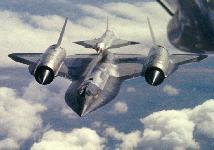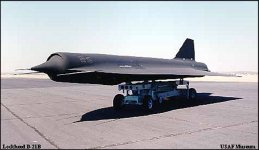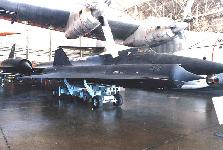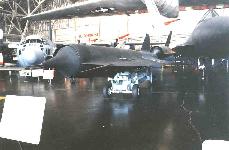


SENIOR BOWL D-21
TAGBOARD
 The Lockheed D-21 (Project Tagboard) was an unmanned or "drone" aircraft designed to carry out high-speed, high-altitude strategic reconnaissance missions over hostile territory. It is a product of the Lockheed "Skunk Works" program that developed the A-12, YF-12, and SR-71 "Blackbird" manned aircraft in the 1960's. The D-21 ramjet-powered reconnaissance drone was powered by a Marquardt RJ-43-MA-11 ramjet. Cruising at Mach 3.3 at an altitude of 90,000 feet, the D-21 had a range of over 3400 nautical miles. The D-21 was guided by an inertial navigation system on a pre-programmed flight profile.
The Lockheed D-21 (Project Tagboard) was an unmanned or "drone" aircraft designed to carry out high-speed, high-altitude strategic reconnaissance missions over hostile territory. It is a product of the Lockheed "Skunk Works" program that developed the A-12, YF-12, and SR-71 "Blackbird" manned aircraft in the 1960's. The D-21 ramjet-powered reconnaissance drone was powered by a Marquardt RJ-43-MA-11 ramjet. Cruising at Mach 3.3 at an altitude of 90,000 feet, the D-21 had a range of over 3400 nautical miles. The D-21 was guided by an inertial navigation system on a pre-programmed flight profile.
Originally, the D-21 was designed to be launched from the back of a modified A-12 (redesignated M-12) carrier aircraft. The first flight of the D-21/M-12 combination took place on December 22, 1964, but the first D-21 release from an M-12 did not occur until March 5, 1966. two more launches were successful, but on July 30, 1966, a D-21 collided with the M-12 after release, destroying both aircraft and resulting in the death of one of the M-12's crew members. No further "piggyback" launches were attempted.
A new launch system was developed using modified B-52H aircraft as carriers. The new D-21 configuration (designated D-21B) had dorsal mounting hooks for carriage under the B-52's wing, and a solid rocket booster for the initial acceleration required to start the ramjet engine. The first launch from a B-52 took place on November 6, 1967, but the D-21 crashed.
Several flights followed in 1968 with mixed success.
The first operational launch was on November 9, 1969, but the D-21B was lost. Several successful operational missions were flown over the next two years, but the D-21 program was highly classified and details have not been released. The program was canceled in 1971 and the D-21s were placed in storage.
SPECIFICATIONS
Span: 19 ft.
Length: 43 ft.
Height: 6 ft.
Weight: 11,200 lbs. without booster
Booster: Lockheed Propulsion Co. solid propellant rocket
Engine: Marquardt RJ-43 ramjet
Armament: None
Crew: None
PERFORMANCE
Maximum speed: Mach 3.3
Range: 3,400+ miles
Service Ceiling: above 90,000 ft.



Sources and Methods
http://www.fas.org/irp/program/collect/d-21.htm
Created by John Pike
Maintained by Steven Aftergood
Updated Saturday, June 21, 1997 11:14:49 AM





 The Lockheed D-21 (Project Tagboard) was an unmanned or "drone" aircraft designed to carry out high-speed, high-altitude strategic reconnaissance missions over hostile territory. It is a product of the Lockheed "Skunk Works" program that developed the A-12, YF-12, and SR-71 "Blackbird" manned aircraft in the 1960's. The D-21 ramjet-powered reconnaissance drone was powered by a Marquardt RJ-43-MA-11 ramjet. Cruising at Mach 3.3 at an altitude of 90,000 feet, the D-21 had a range of over 3400 nautical miles. The D-21 was guided by an inertial navigation system on a pre-programmed flight profile.
The Lockheed D-21 (Project Tagboard) was an unmanned or "drone" aircraft designed to carry out high-speed, high-altitude strategic reconnaissance missions over hostile territory. It is a product of the Lockheed "Skunk Works" program that developed the A-12, YF-12, and SR-71 "Blackbird" manned aircraft in the 1960's. The D-21 ramjet-powered reconnaissance drone was powered by a Marquardt RJ-43-MA-11 ramjet. Cruising at Mach 3.3 at an altitude of 90,000 feet, the D-21 had a range of over 3400 nautical miles. The D-21 was guided by an inertial navigation system on a pre-programmed flight profile.



